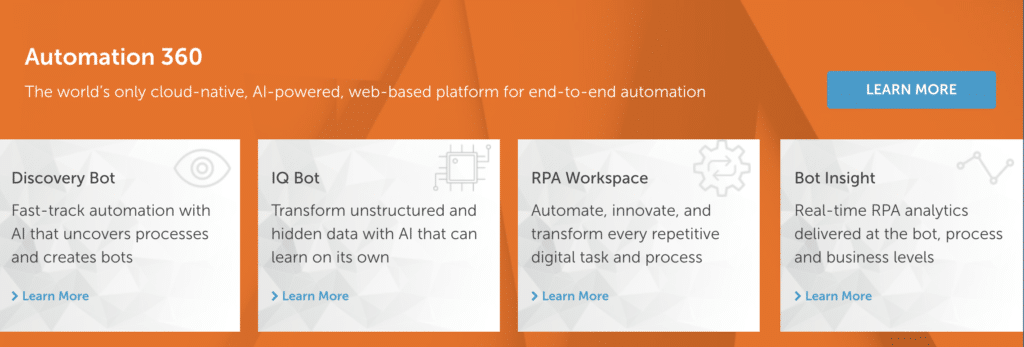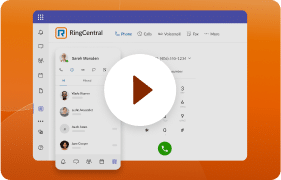RPA (Robotic Process Automation) has become hugely popular due to its ease of implementation and the fact it can significantly boost ROI. Finding the best RPA tools for your small business can seem daunting, but we’ve got you covered.
An estimated 53% of businesses have already started their RPA journey, and in just five years it’s expected that nearly all companies will have adopted this kind of intelligent automation in one form or another.
Here’s what we’ll cover today:
- What is Robotic Process Automation (RPA)?
- What are the business benefits of RPA?
- 7 ways industries are benefiting from RPA tools in 2021
- 10 Core factors of an effective RPA tool
- 26 best RPA tools to automate and optimize your business
Did you know 1 in 4 businesses are experiencing a decrease in productivity over the last few months? Learn more in our State of Hybrid Work report.
What is Robotic Process Automation (RPA)?
Robotic process automation (RPA) is a technology that makes it easy to build and manage ‘robots’ that mimic human interactions with digital systems and softwares.
RPA helps companies eliminate tedious manual tasks through solutions like document processing automation, freeing up employees to focus on core processes.
Some use an RPA solution as a stopgap on the way to incorporating intelligent automation (IA) and machine learning (ML). These tools are able to make judgments about future outputs, and some RPA solutions already incorporate these new technologies.
Just like people, these robots can understand how to read a screen, complete the appropriate keystrokes, identify and pull out data, navigate systems, and carry out a wide range of defined actions. The bonus is that they can do this far faster than humans can (and without having to take a coffee break).
You can learn more from this Robotic Process Automation explainer and this RPA video.
What are the business benefits of RPA?
- RPA streamlines workflows and makes organizations more efficient, profitable, and responsive. It also creates a happier workforce that’s more engaged and productive because it removes previously mundane tasks from their ‘to do’ list.
- The tech is non-disruptive and is fast and easy to incorporate in order to speed up digital transformation. It’s perfect for creating automated workflows in legacy systems that may lack APIs or VDI’s (virtual desktop infrastructures).
- RPA can help companies make significant cost savings by driving big improvements in business metrics. RPA is low-cost and easy to deploy, requiring no customization of software or deep systems integration.
- RPA bots can quickly ramp up your processes, in order to match peak workloads and respond to spikes in demand.
- Using RPA technology leads to greater accuracy, significantly reducing incidents of human error.
- Robotic processing automation improves compliance, enabling companies to meet or exceed their compliance expectations.
- Using RPA software allows companies to become more strategy-led with executives’ time freed up to focus on driving the business forward.
- Software increases job satisfaction for employees and makes them more engaged and productive.

7 ways industries are benefiting from RPA tools in 2021
More and more companies are seeing the benefits of RPA, in industries ranging from manufacturing and healthcare to the finance and insurance sector.
Benefits range from increased productivity and customer satisfaction to improved analytics and HR performance. From Walmart and Deutsche Bank to Ernst & Young and American Express, enterprises across the globe are rapidly adopting RPA.
Here are some ways industries are seeing improvements:
1. Better business results
By enabling employees to focus on high value activities businesses are seeing improvements in their bottom line.
By automating certain business activities, such as data entry, call center agents can spend more time on higher level tasks. Actually speaking to customers with complex issues, for instance. RPA automates lower value positions and allows humans to focus on value adding activities.
2. Lower wage costs
In certain industries, such as banking, it’s likely that a lot of back-end processes will be replaced by RPA automation. With robotic processes making some positions redundant, companies can redeploy staff if relevant opportunities exist or upskill them to ensure they are a good fit for other types of jobs.
Even when all staff are redeployed, automation will make for a leaner organizational structure and cost savings.
3. Reduced risk
When upgrading systems, companies sometimes go over budget without seeing any real results. Incorporating RPA is low risk and non-invasive, ensuring projects get completed more quickly—using both attended automation or unattended automation—without causing disturbance to existing systems.
Here are a couple use cases of how RPA has helped companies mitigate risk:
- Addiko Bank was able to reduce their complex loan decision times from a week to three working days by automating the loan decision process.
- American Express Global Business Travel uses RPA to automate processes for canceling airline tickets and issuing refunds, thereby boosting customer satisfaction levels.
4. Increased customer satisfaction
Once RPA is implemented, companies can reduce or eliminate human error during the sales process and other crucial areas of business, and customers will reap the benefits.
By reducing errors it will be easier, for instance, for a contact center agent to identify a customer’s issues more quickly and address their queries.
Companies will also be able to offer better speed of service to customers. Rather than having to manually enter forms into the system or copy data between systems, RPA can do this at lightning speed.
As an example, many credit approvals and card management processes are now automated, increasing the speed and efficiency for customers.
5. Improved data quality
A reduction of errors means that organizations will have access to better quality data, thereby leading to more reliable analyses.
Robots can interact with legacy systems and uncover data that wasn’t previously available or was too labor intensive to extract. This means the analytics team can access more data and be able to carry out more in-depth analysis.
6. Improvements in HR
RPA means employees no longer have to spend their days copying data from one system to another. By incorporating no code RPA companies can democratize the development of automation so that teams can build and maintain their own automated systems.
This is not only empowering, but means they can then focus on more interesting and challenging tasks, leading to a better employee experience.
More and more companies are investing in RPA technology for their HR departments, reclaiming a big percentage of their time and increasing employee satisfaction levels.
Staff can spend less time identifying and assessing candidates and more time meeting with suitable candidates, attending networking events, or investing in training.
Here’s an example of RPA software evaluating resumes:
7. Increased compliance
Thanks to RPA, organizations can minimize their exposure to sensitive information because human interaction with this data is reduced. This results in a lower probability of fraud and non-compliance. The decision to implement RPA also enables companies to maintain detailed audit trails.
10 core factors of an effective RPA tool
There’s no shortage of vendors when it comes to the field of robotic process automation, so it can be difficult making a decision on who to opt for.
RPA product features are many and diverse—so which should you have on your radar?
1. Ease of implementation
It’s important to opt for an RPA system that is easy to implement, that is non-invasive, and compatible with your existing software. Check how capable the RPA tool is in terms of integrating with existing systems to avoid downtime and allow for a smooth transition.
2. Ease of use
Choose a tool that’s easy to use so that employees require little training. A no-code RPA solution is ideal, as it’s appropriate for all levels of user, with or without a background in technology. That way, business analysts should be able to use the software even if they don’t have any programming knowledge.
3. Speed of automation tools
The aim of an RPA tool is to improve the speed of business processes, so this is one of the most important criteria to consider. Make sure your selected tool increases speed by ensuring it can carry out all the tasks you need quickly—and that it has rapid mapping processes.
4. Technical specs
Ensure your RPA system has the requisite technical features including:
- Screen scraping
- Scalability
- Cognitive capabilities
- Superior security features (in order to minimize exposure to malicious attacks, misuse of data, and privacy issues)
5. Cost of ownership
The total ownership cost is another factor to consider before purchasing an RPA tool. This will depend on various factors including vendor fees, cost of implementation, license fee, and ongoing maintenance.
6. Scalability
An important aspect of scalability is how and where an RPA solution is used in a company, and how that may expand in future.
It’s important to choose a tool that is easy to integrate with other technologies, and that has expanded accessibility.
7. Exception handling
Your RPA tool should have a well-designed exception handling function so it can detect errors automatically, faster than via human detection.
Sometimes errors will need manual attention. In these cases, your RPA system should be able to direct these exceptions to the right person with the relevant expertise. If no attention is required, errors are handled by the robot. If your system is prone to errors, choose a tool with robust exception handling abilities.
8. Customer support and tutorials
Your RPA provider should be able to support you with reliable, consistent service so you can experience a smooth deployment and make use of any upcoming technical innovations.
9. Architecture
A good RPA tool needs to be adaptable and able to perform various previously time-consuming tasks within an organization.
Make sure employees have the right skills and experience to make the most of your tool, and ensure you have an understanding of where not to use the robots. If the selected RPA system suits your needs correctly, all complex designs and processes can be automated so they become more efficient.
10. Governance
Your chosen business process automation tool should be able to provide good visibility to all stakeholders, and everyone involved in all the processes. With notifications, pending actions, ROI dashboards, and other control and monitoring systems.
26 best RPA tools to automate and optimize your business
There are various RPA vendors on the market, each with their own specific features, some of which are better suited to certain types of organizations.
While we’re undoubtedly biased (you’ll find as at number one below), we’re going to be entirely fair. The following list contains only genuine features and legitimate analyses of each tool:
1. Automation Anywhere: RPA software for financial services, healthcare and insurance companies

This is a cloud-native and web based AI platform with a large expanse of business operations capabilities. Automation Anywhere helps organizations create and maintain a digital workforce of software bots that complete end-to-end business processes.
Drag and drop features are easy to implement, and the solution has a reasonable pricing structure. The software comes with hands-on tutorials and webinars, as well as extensive modular training.
Automation Anywhere offers a host of benefits:
- Delivers an integrated and seamless experience
- RPA bots can run both attended and unattended, so they can assist employees in real time or run in the background on a virtual machine, taking care of back-end processes like data entry, unseen
- Secure RPA command center allowing for the efficient scheduling, management, and execution, as well as analytics of bots
- Integrates with a multitude of applications
- Features automating optical character recognition
- Debugging facilities highlight errors on tasks and enable users to detect issues
- Deploying, managing, and repairing automations is convenient with scheduling and prioritization taking place automatically
2. Eggplant: RPA of choice for leading organizations
Eggplant Software empowers organizations to develop superior digital experience for customers. The RPA provider helps businesses to monitor and analyze end-to-end customer experience in order to achieve better business outcomes.
Pros
- Uses model based testing and AI to automate testing processes
- Helps to monitor insights post production and do load testing
- Can schedule and maintain test assets in one place and create detailed logs
- Automates desktop based apps and web based apps using image and OCR Recognition
Cons
- It’s not open source software and can’t be managed in-house
- Some users report that the reporting mechanism needs improvement
3. OutSystems: good for mobile platforms
OutSystems is a low-code rapid application development software trusted by thousands of companies worldwide. It’s a solution that combines the power of low-code development with advanced mobile capabilities.
Pros
- Allows for visual development of app portfolios
- Integrates easily with existing systems
- Performs automatic dependency checking
- Very scalable solution
- No lock in and centrally hosted
Cons
- Some users report limited AI capabilities
- Relatively expensive solution
4. HelpSystems: for automation that scales
HelpSystems is a solution that helps businesses automate routine tasks with easy to configure robots for full-scale enterprise automation.
Features include intelligent document processing and data scraping, and the extraction of web browser tasks to integrate with critical business apps.
Pros
- Runs custom SQL reports and sends automated reports generated by other systems
- Sends exception alerts and reminders to keep things on schedule
- Features email/SMTP communications
- Uses logic-based tools
Cons
- Some users report a lack of sufficient tools around system stability
- Doesn’t support task shortcuts to run specific tasks
5. Kofax: reliable end-to-end solution
Kofax Insight delivers analytics and process intelligence functionalities to help businesses monitor and optimize operational processes.
Pros
- Creates rich visualizations, analytics, and integration in an end-to-end solution
- Supports operational performance and compliance
- Enables businesses to understand customer behavior patterns
- Easy for anyone in the organization to use
Cons
- Limited use of robots
- Some users report a non-user friendly interface
- Could be more support for AI
6. Agenty: Best for data scraping
Agenty is a scalable, cloud-based SaaS RPA solution that has a host of features including data scraping, web automation, text extraction, OCR, and change detection. The software is easy to use with no coding requirements.
Pros
- Features a sentiment analysis agent to extract negative or neutral sentiment with confidence score from an Excel file or agent
- Machine translation agent can translate input text in selected language using machine based API
- Easy to set up
- Easy to scale
Cons
- Some report poor customer service
7. Microsoft Power Automate RPA: for automation with less code
Power Automate (previously Microsoft Flow) automates manual paper-based processes and can create new automations and processes within different departments. Capabilities range from sending emails to big functionalities such as getting multi-chain approvals.
Pros
- Integrates with many other applications, including Microsoft 365
- Schedules flows efficiently
- Sends reminders and approvals
- Easy to use interface and templates
Cons
- Isn’t entirely low-code, so does require some skill to use
- Could have better logging capabilities
8. Zoho: best for CRM
Zoho is a cloud-based integrated Customer Relationship Management platform that has extended support for phone, email, live chat, and social media.
Zoho’s AI-powered sales assistant, Zia, can provide advanced interpretations and solutions for the sales team so reps can spend more time selling and less entering data.
Pros
- Provides top level workflow automation and lead scoring
- Sends real-time notifications
- Has advanced analytics features and process management
- Easy to onboard
- Has a developer platform
Cons
- Some users report that security could be improved
- Can be difficult to navigate
9. Pega: Automation software for sales, marketing, service, and operations
Pega is a reliable RPA platform for companies looking to accelerate strategic change. The solution can be deployed across several departments, enabling companies to fill gaps and provide infrastructure to evolve a business.
Pros
- Provides industry-specific solutions
- Ability to integrate with a broad range of partners
- Scalability, reusability of code, and ease of customization according to business or channel
- Easy to manage multiple teams who are developing code quickly
- Offers a Decision Strategy Manager
Cons
- Could introduce more reporting features and would be better if developers had more features with which to customize reports
- Documentation is not clear to some users who claim it misses key features or is incorrect
10. Contextor: an industrial approach to process automation
Contextor is an innovative software solution that’s based on the performance of real-time interactions. The system interacts with all a workstation’s applications simultaneously. Contextor is designed to help companies elevate their customers’ experience.
Pros
- Scalable solution
- Good ease of use
- Integrates with a large number of third party apps
- Applies changes automatically
- Remotely analyses robots in production reducing maintenance time
Cons
- Some users report slow customer support
11. Kryon: for accelerating time to production
Kryon is an automation solution that features full-cycle automation and encompasses task and process mining, process discovery, and automation. Kyron can be easily scaled into partner platforms including Software AG and Verint.
Pros
- Generates visualizations allowing users to identify the best automation fits
- Can be used for training purposes by suggesting the best paths for completing path processes of unstructured data
- User-friendly for both business users and experienced developers
- Allows users to start from process discovery
- It’s easy for users to define fallbacks and error-handling procedures
- High levels of engagement
- Good support quality
Cons
- Customers sometimes mention Kryon has a slightly low bot performance
- Kryon requires robust integrations with ABBYY, Microsoft Cognitive Services, and others for analytics and processing
12. WinAutomation by Softomotive: Best for Windows apps
WinAutomation by Softomotive is a world class desktop automation tool that provides a powerful Windows-based platform for building software robots. It brings the benefits of RPA and helps companies reduce costs and improve productivity and accuracy of processes.
Pros
- State of the art learning portal so students can learn and develop RPA skills
- Can cope with simple admin tasks as well as complex business processes
- Reasonably priced with a free trial period
- Easy to use interface
- Quick to deploy for smaller automation tasks
Cons
- It can be challenging dealing with OCR text recognition
- Some users question the software’s stability
13. Antworks: best for research and consulting
Antworks has an integrated platform, ANTstein, which uses Cognitive Machine Reading (CMR) technology. It processes various types of data including printed, handwritten, stamps, and signatures, and enables humans and bots to work together on one machine.
Pros
- Processes unstructured data which makes up a large amount of the data in various industries
- Addresses the limitations of RPA by processing structured, unstructured, image, and inferred data quickly
- Needs minimal code so assigning tasks is easy
Cons
- Human support is still required to make decisions
14. Blue Prism: for project managers
Blue Prism is a market leading tool that automates tasks, from HR processes to accounting and finance functionalities, without requiring human intervention. The software is easy to scale and designed as a platform to fit wider enterprise systems.
Pros
- User-friendly and easy to manipulate and handle data
- Easy to set up automated emails
- Consistently secure when handling sensitive data
- Once processes are implemented, performs these with high degree of accuracy
- Customer support is good with forums a resource for resolution of issues
- Can handle a large amount of data
Cons
- A little more pricey than some other RPA software
- Some users report that object recognition could be improved
- Software is not as visually attractive as some other systems
15. EdgeVerve: value for money solution
EdgeVerve is attractive for businesses, big and small, and comes equipped with various specialist features including call center automation, testing, and legal contract analysis. Has a useful set of tools allowing for convenient scaling, version updates, and data migration.
Pros
- Bot governance and runtime features are sophisticated and suitable for a larger company’s auditing demands
- Has an API solution for integrating with third parties
- High level of security
- Efficient service and quality of innovation with 24/7 access to customer support
- Low cost compared with many other providers
Cons
- Root cause analysis of robot failures could be improved, as well as maintenance capabilities
- Installation requires a significant amount of human intervention
16. Citrix: RPA for reviewing consumer behavior
An intuitive analytics service that enables users to monitor and identify inconsistencies and suspicious activities on networks. Using machine learning and advanced algorithms it provides valuable insights into user behavior, based on indicators including endpoints and network traffic.
Pros
- Easy to manage for XenApp and XenDesktop
- Good for remote multiple access
- Simple and elegant user interaction
- Easy to set customizable targets
Cons
- Initial installation can be time consuming
- User stability not always as good as desired
17. Jacada: self-service automation
Jacada RPA applies end-to-end customer service automation across self and assisted-service. The software uses RPA and intelligent guidance together in technology that helps agents and customers work smarter.
Jacada features product scorecards that provide data about features, capabilities, net promoter scores, and satisfaction levels.
Pros
- Offers intelligent engagement to deal with complex problems, such as troubleshooting and regulation
- Works via all channels from voice and chat to email
- Improves operational efficiencies
Cons
- May not be suitable for larger enterprises
18. NICE: for contact centers
NICE is a Gartner magic quadrant leading company, recognized for delivering a solution that’s dedicated, but not limited, to contact center automation.
Its new AI features include real-time speech analytics and real-time inventory checks. NICE also offers next-best offer recommendations for contact center representatives so they can improve a customer’s experience at all parts of their journey.
Pros
- Features an automation finder that collects and analyzes employee data and suggests automations which can be actioned with a click
- Variety of OS, platform, and application connectors
- Text analytics and voice-driven automation with features for contact centers around content, classification, and processing
Cons
- Software robots testing capabilities for unattended automation are limited
- Root-cause analysis of bot failures is tricky
19. NTT Data: for startups and SMEs
NTT-AT’s RPA offers document and performance management, analytics, task management, and UI security. The elastic and scalable software supports both web and Windows.
Pros
- Good image matching functionality
- Wide number of services available
- Strong expertise in customer support
- Easy to use and ability to visualize flows and scenarios
- Flexibility in pricing and contracts
Cons
- Can take some time to develop a robot
20. G1ANT: fast-developing RPA software
G1Ant is one of the fastest growing RPA softwares out there, and is a solution that can be implemented in-house or with the help of the G1ANT software team.
The process automation software is based on scripts with a new language designed purely for the robotization of processes. G1ANT is open source and welcomes developers to share ideas.
Pros
- Easy to set up and install
- Good for beginners, as well as advanced developers
- Customer support is high quality
- Flexible and programmer-friendly
- Ability to test software before buying
Cons
- Could use some more tutorials and resources
- Requires a certain amount of downtime to learn
21. VisualCron: for high quality customer support
VisualCron is an automation, integration, and task scheduling tool for Windows users. No programming skills are required and it features a user-friendly interface that uses drag and drop features. The software provides over a hundred custom tasks for different technologies.
Pros
- Customer driven – development is based on feature requests
- Extended logging – audit, task, and output logs help with debugging requirements
- Handles flows and errors seamlessly
- Affordable solution
- Good customer service
Cons
- Could take some downtime to get to grips with the software
- Tutorials sometimes contain inaccuracies
22. Samsung SDS: big data analytics solution for process automation
Samsung SDS enables companies to gain business insights from big data. The cloud-based platform connects devices and processes data efficiently, shortening the development time for services. The solution is optimized for enterprise-level companies with high scalability, advanced security, and high processing speeds.
Pros
- A one-stop solution in the cloud
- High quality customer support
- Supports a large number of features
- Can be used for customer analytics and CRM
- High level of integration and easy interface
Cons
- Relatively pricey solution
23. SAP RPA: easy way to create intelligent bots
SAP makes it easy to build intelligent robots in order to hyper-automate tasks. SAP technology enables manual tasks to be automated so that resources can be redirected to higher value activities and processes.
Pros
- SAP software is future-proofed for ongoing relevance
- Users can develop bots with a step-by-step sequence and dependencies
- It’s possible to apply APIs and machine learning to make bots intelligent
- Training courses are available at SAP offices or in-house
- Users can access a comprehensive resource center
Cons
- Some customers report that analytics and reporting could be improved
24. Servicetrace: application performance management platform
Servicetrace is a longstanding robotic solutions provider and leader in synthetic user experience monitoring for app performance and test automation. Servicetrace holds a number of patents, and the technology is trusted by global enterprises in all industries.
Pros
- Software monitors business apps from a user perspective
- Operates without any restrictions on all GUIs
- Ideal for insurance, IT, and manufacturing industries
- Can be deployed in production and test environments
Cons
- When deploying a high number of components, e.g. robots, workflows, and reports, navigation can be tricky
25. WorkFusion: best RPA for large volumes of processes and high handling times
WorkFusion works best with processes that are rule-based, and is a good tool for processes which involve high documentation processing—e.g., in banks and other financial institutions.
The software can automate all types of repetitive tasks that have been mapped, and requires little downtime to learn. Workfusion enables automation of the likes of mass email services and reading Excel spreadsheets, etc. Users recommend using an external API to read OCR.
Pros
- Good support from the provider in terms of cost and technical requirements, and users are involved in product development
- Product is constantly upgrading in a bid to compete with leading players in the market
- Merges features of the two largest tools in RPA in terms of captured HTML objects
- Visually pleasing to developers
Cons
- Documentation and course are confusing
- Could do with more integration with 3rd party tools
26. UiPath RPA: for large, global enterprises
UiPath software enables robots to learn new skills via AI and machine learning. UiPath enables users to build robust robots and measure automation performance. This on-premises solution offers a free 60-day trial.
UiPath enables organizations to manage, deploy, and optimize automation at scale and run robots that are attended or unattended—as well as test them.
The software also provides the ability to automatically capture and document processes as you work.
Pros
- The graphical user interface based code editor is highly user friendly
- Good availability of templates of custom processes
- Wide range of integrations with other leading software
- Good collaboration and sharing features and tools
- Advanced AI and machine learning based automation
- State of the art security and authentication features
Cons
- Could include even more integrations and collaboration tools
- Some users point to a lack of stability
Choosing an RPA tool
Becoming an agile enterprise means having to operate a seamless mix of digital workers, human workers, and dynamically automated systems—from the back office to front office customer service. Robotic process automation enables you to create new transformative ways to work, empowering people to focus on the issues that matter most to a business.
Adopting robust RPA software also allows you to gain better insights and control over the way work is carried out, and make better decisions around improvement. When it comes to selecting an RPA provider, make sure to do your research. They all come with a different set of capabilities, along with a lower or higher price tag.
Originally published Jun 28, 2021, updated Mar 13, 2025











